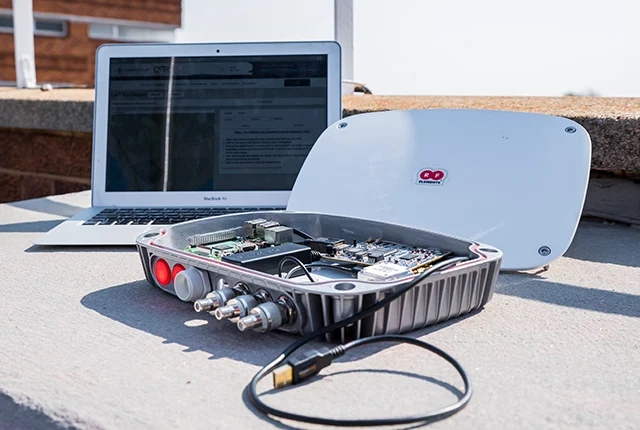How unused TV spectrum can deliver affordable Internet

Chunks of electromagnetic frequency spectrum known as Television White Spaces (TVWS) can be used to provide affordable broadband Internet to South Africans.
The potential of this spectrum has been boosted by ICASA’s decision to authorise the use by TVWS operators for the duration of the COVID-19 State of Disaster.
This measure was implemented along with the temporary emergency allocation of spectrum to mobile operators.
To support this, the Council for Scientific and Industrial Research (CSIR) has announced an initiative to provide the technology it has developed to assist with the deployment of TVWS networks, free of charge.
“This is in an effort to improve the national broadband Internet capacity and provide relevant and up-to-date information to the public in the fight against the COVID-19 pandemic,” CSIR Impact Area Manager Ntsibane Ntlatlapa said.
These networks are ideal for delivering broadband to underserved communities and to supplement connectivity in locations with heavy mobile network congestion.
In South Africa, analogue television programming is broadcasted over radio waves within the lower ranges of EMF spectrum.
TVWS are portions or gaps of unused radio spectrum left between bands allocated to TV broadcasters in the Ultra High Frequency (UHF) Range.
These gaps are found between the frequencies of 470MHz and 694MHz, and appear as the “snow” viewers would see when searching for analogue TV channels.
TVWS spectrum can be especially useful for providing mid-speed connectivity over large areas.
The characteristics of waves in this band make them capable of transmitting over long distances and penetrating both man-made and natural objects.
These waves can transfer data at speeds of approximately 24Mbps over a 10km distance.
Geo-location spectrum databases
In order to transmit broadband connectivity over TVWS, there needs to be control of which channels can be used within specific geographic locations to avoid overlapping or interference of signals with incumbent users.
For this, ICASA has determined a three-tiered ecosystem in its TVWS regulations published in March 2018.
Two types of geo-location spectrum databases (GLSD) – the Reference GLSD (R-GLSD) and Secondary GLSD (S-GLSD) – occupy the first and second tier, respectively.
ICASA operates a single R-GLSD to perform baseline calculations for South Africa’s TVWS availability maps in order to set appropriate regulatory limits.
Multiple S-GLSDs are managed by qualified GLSD providers, of which the CSIR is one. The S-GLSD delivers automated control of spectrum by determining the exact frequency of unused spectrum in the UHF range.
It therefore acts as a “Spectrum Switch” that ensures the radio equipment used to provide TVWS broadband connectivity does not interfere with channels in use.
How to access Internet connectivity
Radio equipment known as White Spaces Devices (WSDs) is used by operators to provide Internet connectivity without an exclusive broadcast license within ICASA-certified spectrum bands.
Two types of WSDs are defined by ICASA’s TWVS Regulations – namely Fixed and Nomadic, which are also called Master and Client WSDs.
Former Senior Engineer at Internet Solutions Roger Hislop has explained TVWS is especially suitable to low-cost operators, such as members of the Wireless Access Providers’ Association (WAPA).
This includes Wireless Internet Service Providers (WISPs), who use unlicensed spectrum allocated for Wi-Fi use to provide connectivity.
“Operators do not need vast capital reserves to install TVWS networks in the way that our mobile network operators need to fund their infrastructure,” he said.
Hislop noted that this equipment is power-efficient and can be easily powered by solar energy. Additionally, providers don’t have to pay for the licensing of spectrum.
“In other words, for TVWS operators the barriers to entry and operating costs are low. This means that the possibility for an entirely new generation of disruptive network service providers to enter the sector is very real,” Hislop stated.
The CSIR provided a breakdown of the typical pricing of the equipment needed to roll out a TVWS base station with Master WSD and CPE with Client WSD.
A three-sector base station kit works out to just under R85,400, while a CPE costs around R15,400.
CSIR and TIA partnership
The CSIR has been working in the fields of Dynamic Spectrum Access and Spectrum Management since 2009 and has developed its own S-GLSD platform.
“The CSIR S-GLSD is a crucial technology for enabling Internet service providers to deploy TVWS broadband networks rapidly on a geolocation basis to hard-to-reach and underserved communities during the COVID-19 pandemic period,” the council said.
“The CSIR has invited interested TVWS network operators approved by ICASA to use its S-GLSD services free of charge.”
It has partnered with the Technology Innovation Agency (TIA) to provide the funding needed to make GLSD technologies freely available to SMMEs who are interested in providing broadband Internet services by deploying TVWS networks.
CSIR chief researcher Dr Fisseha Mekuria said this collaboration will support the provision of “life-saving information and enable online learning for populations,” particularly in previously disadvantaged and rural communities.
The full, original article can be found here.

0 Comments